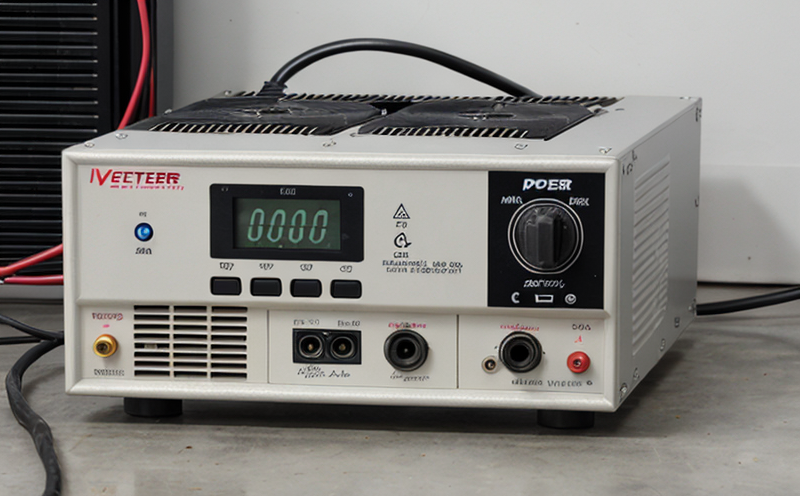IEC 62786 Grid Code Compliance Testing of Inverters
The International Electrotechnical Commission (IEC) Standard IEC 62786 sets out the requirements for grid-connected inverters and their interaction with power systems. This standard ensures that inverters can operate safely, reliably, and efficiently while maintaining stability in a variety of grid conditions.
Our laboratory provides comprehensive testing services to ensure compliance with these stringent standards. We employ state-of-the-art equipment and follow the most current versions of IEC 62786 to provide accurate and reliable test results. Our expertise spans across various types of photovoltaic (PV) inverters, battery storage systems, and hybrid systems.
Compliance testing with IEC 62786 is essential for manufacturers, developers, and operators who wish to ensure their products meet international standards and can operate safely within diverse power system environments. By adhering to these stringent specifications, you guarantee your inverters’ performance under real-world conditions, which ultimately leads to safer grid integration.
Our testing process includes a series of simulations that replicate the dynamic behavior of the grid and how an inverter would respond. This allows us to identify potential issues early on, ensuring that any necessary adjustments are made before deployment. Our team is well-versed in interpreting test results against IEC 62786 criteria and providing actionable recommendations.
With our comprehensive testing services, you can rest assured knowing your inverters meet the highest industry standards. Whether it's for research and development or ensuring compliance with regulatory requirements, we offer a tailored approach to help you achieve your goals efficiently.
Why It Matters
The importance of IEC 62786 grid code compliance testing cannot be overstated. As the global demand for renewable energy continues to grow, so does the need for reliable and efficient inverters that can seamlessly integrate into existing power grids.
Compliance with these standards ensures that your inverters are capable of handling a wide range of grid conditions. This includes voltage fluctuations, frequency deviations, and other transient events that occur in real-world scenarios. By simulating these conditions during testing, we provide you with valuable insights into how well your equipment will perform under actual operating conditions.
Moreover, IEC 62786 compliance is a key requirement for many countries when it comes to grid connection permissions and certifications. Meeting this standard not only opens up markets but also builds trust among stakeholders by demonstrating a commitment to safety and reliability.
In addition to regulatory requirements, adhering to these standards helps protect your brand’s reputation. Consumers are increasingly aware of the environmental impact of products they purchase. By ensuring that your inverters meet rigorous international standards, you position yourself as a leader in sustainability and innovation within the industry.
Benefits
The benefits of undergoing IEC 62786 grid code compliance testing extend far beyond mere regulatory satisfaction. Here are some key advantages:
- Avoid Regulatory Penalties: Non-compliance can lead to fines, delays in market entry, or even prohibition from operating within certain jurisdictions.
- Enhanced Safety: Ensures the safe operation of inverters under various grid conditions, reducing risks associated with potential failures.
- Better Performance: Identifies areas for improvement early on, leading to enhanced performance and efficiency of your products.
- Increased Market Access: Compliance opens up opportunities in markets that require stringent standards for grid-connected devices.
- Promotional Value: Demonstrates leadership in sustainability and innovation, enhancing your brand’s reputation among consumers.
In summary, IEC 62786 compliance testing is not just a requirement; it's an investment in the future success of your products. By ensuring that your inverters meet these standards, you set yourself apart from competitors and pave the way for long-term growth and sustainability within the renewable energy sector.
Use Cases and Application Examples
| Use Case | Description |
|---|---|
| Residential PV Systems: | Testing inverters used in residential solar installations to ensure they function correctly when connected to the grid. |
| Commercial Solar Farms: | Evaluating inverters for commercial-scale photovoltaic farms to guarantee reliable operation and efficient energy production. |
| Battery Storage Systems: | Assessing the interaction between battery storage systems and the grid, ensuring seamless integration and optimal performance. |
| HVDC Grids: | Testing inverters in high-voltage direct current (HVDC) applications to ensure they meet stringent safety and efficiency requirements. |
| Hybrid Systems: | Evaluating inverters that are part of hybrid systems combining different renewable energy sources, such as solar PV and wind power. |
| Microgrids: | Testing inverters in microgrid configurations to ensure they can operate autonomously or in conjunction with the main grid. |
| Distributed Generation: | Evaluating inverters used for distributed generation applications, where small-scale renewable energy sources are integrated into local grids. |
| Smart Grids: | Assessing the interoperability of inverters with smart grid technologies to support advanced communication and control functions. |
Each use case highlights the versatility and importance of IEC 62786 compliance testing. These tests ensure that inverters can operate safely, efficiently, and reliably across a wide range of applications, contributing significantly to the overall performance and reliability of renewable energy systems.





